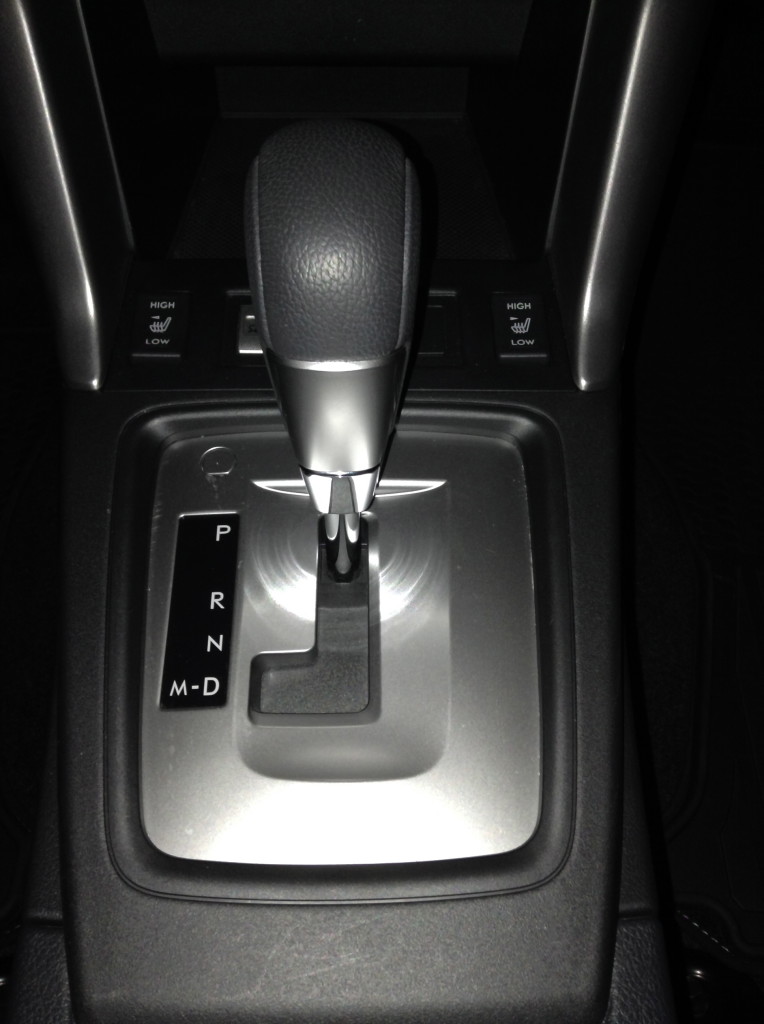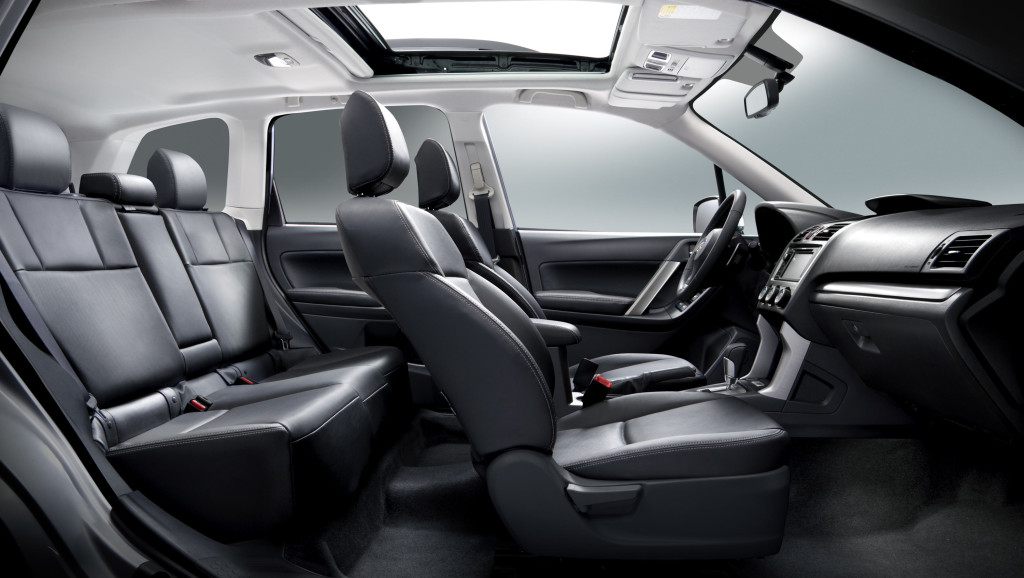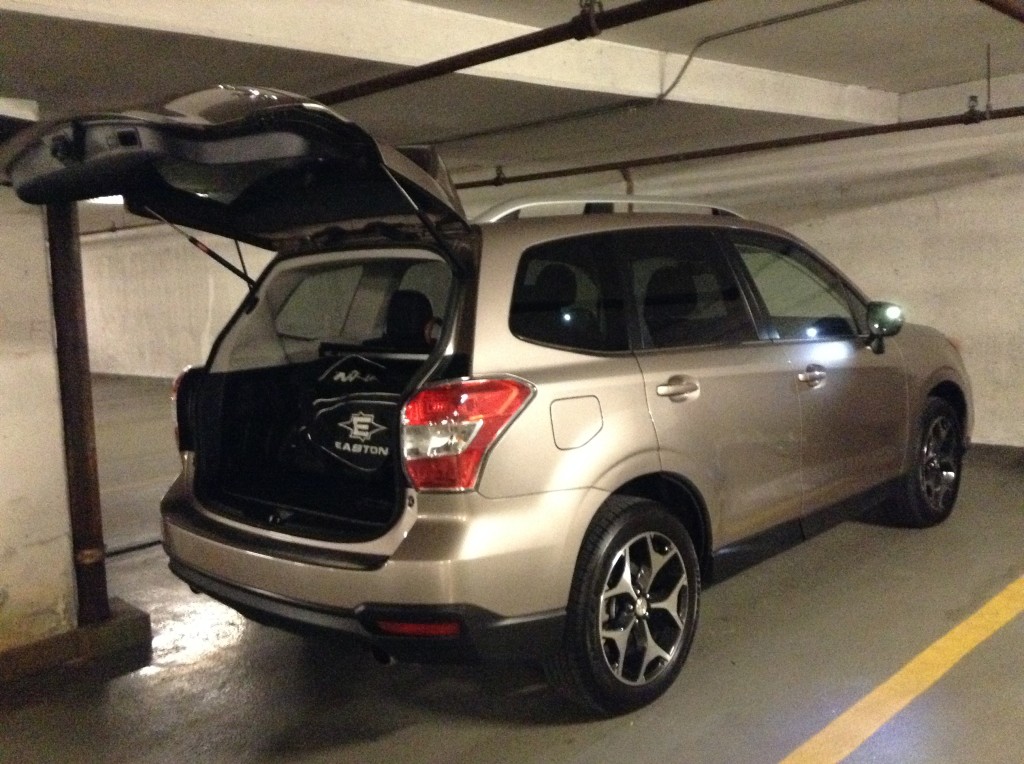Little of what I learn about automobiles surprises me. That said, I wouldn’t expect to find paddle shifters in a SUV, compact or otherwise. Yet that’s exactly what I did find in a 2014 Subaru Forester XT.
At first I was surprised. Then, I was pleased, and not just because this was going to be the first time I got to spend a whole week with a paddle-shifter-equipped vehicle.
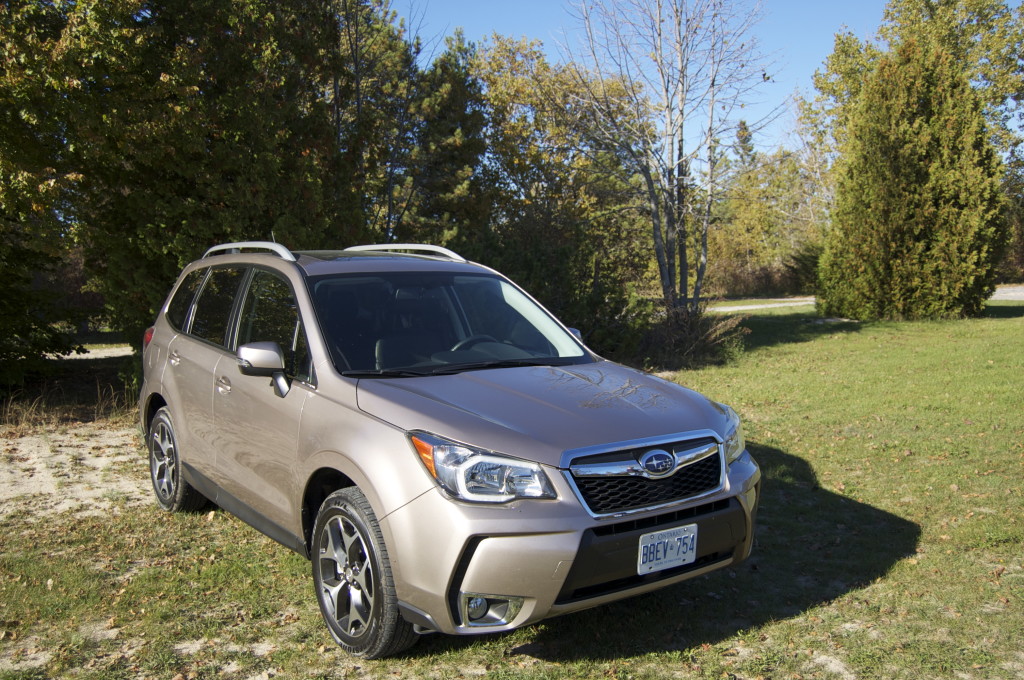
The 2014 Subaru Forester XT hanging out at Sandbanks Provincial Park, Prince Edward County, Ontario. Photo: Josephine Pica
Paddle shifters – a quick overview
Why was I surprised? Consider the origins of paddle shifters. While other racing outfits had previously experimented with similar semi-automatic transmissions, Ferrari brought them to prominence by being the first team to win a Formula One race using paddle-shifters more than two decades ago.
The most obvious parts of the system are the two identical paddles that sit just behind the steering wheel. Pull the right paddle, and you shift up a gear. Pull the left paddle, and you shift down a gear. In some vehicles, you can pull both at the same time to get other options, like reversing. These paddles are commonly labeled using a “+” and “-“ respectively. (The system reminds me of a motorcycle gearshift, but I’ll save that tangent for another day.)
While in motion, drivers keep their hands on the wheel at 9 o’clock and 3 o’clock while shifting gears instead of reaching for a gearshift level. Combined with an “automatic” clutch (i.e. no third pedal, the one to the left of the brake), the system gives drivers the ability to shift more quickly, keep better control of the car and devote more attention to the road ahead.
Following Ferrari’s lead, every team in Formula One uses paddle shifters fitted to steering wheels that cost more than my car. Eventually, this sophisticated shifting system made its way to sports cars, then sedans, even lower-priced vehicles, including later models of my car. And, to my surprise, even compact SUVs, which makes driving them much more fun.
Reconnecting with the act of driving
The more I think about it, the more I realize that’s a good thing. I’ve long believed that one way to get drivers to pay more attention to driving (and less to the myriad distractions that make innovations like Subaru’s EyeSight system a great idea) is to encourage more drivers to actually shift gears in their cars. (I’ll return to that theme throughout this post.)
That can be a tall order. The thought of dealing with a third pedal or a gearshift lever seems to intimidate many drivers (at least in North America – all my relatives in Italy drive cars with manual transmissions, and I understand that’s the norm throughout Europe).
So offering paddle shifters, sans the added burden of learning how to use a clutch, might help drivers get more in tune with their cars.
The obvious rebuttal here is that paddle-shifter-equipped cars can also be driven as automatics. But at least the paddle shifters, with their placement on the steering wheel, might entice more drivers to try the system. In doing so, they may find they’re more connected to the vehicle, the road, the whole experience of driving. And that they’re having more fun.
Paddle-shifting – how it works
It’s an easy system to learn. I moved the Forester’s shift lever down to D, then over to M. I stepped on the accelerator and got going in first gear, as indicated by a “1” and an up-arrow on the dash between the tachometer and the speedometer. When the engine revved more audibly, I pulled the “+” paddle. The number changed to “2” and a down arrow joined the up arrow on the dash as the engine noise subsided and I continued to accelerate.
(The up and down arrows merely indicate whether an up-shift or down-shift is available. When you’re in first, for instance, you can’t down-shift.)
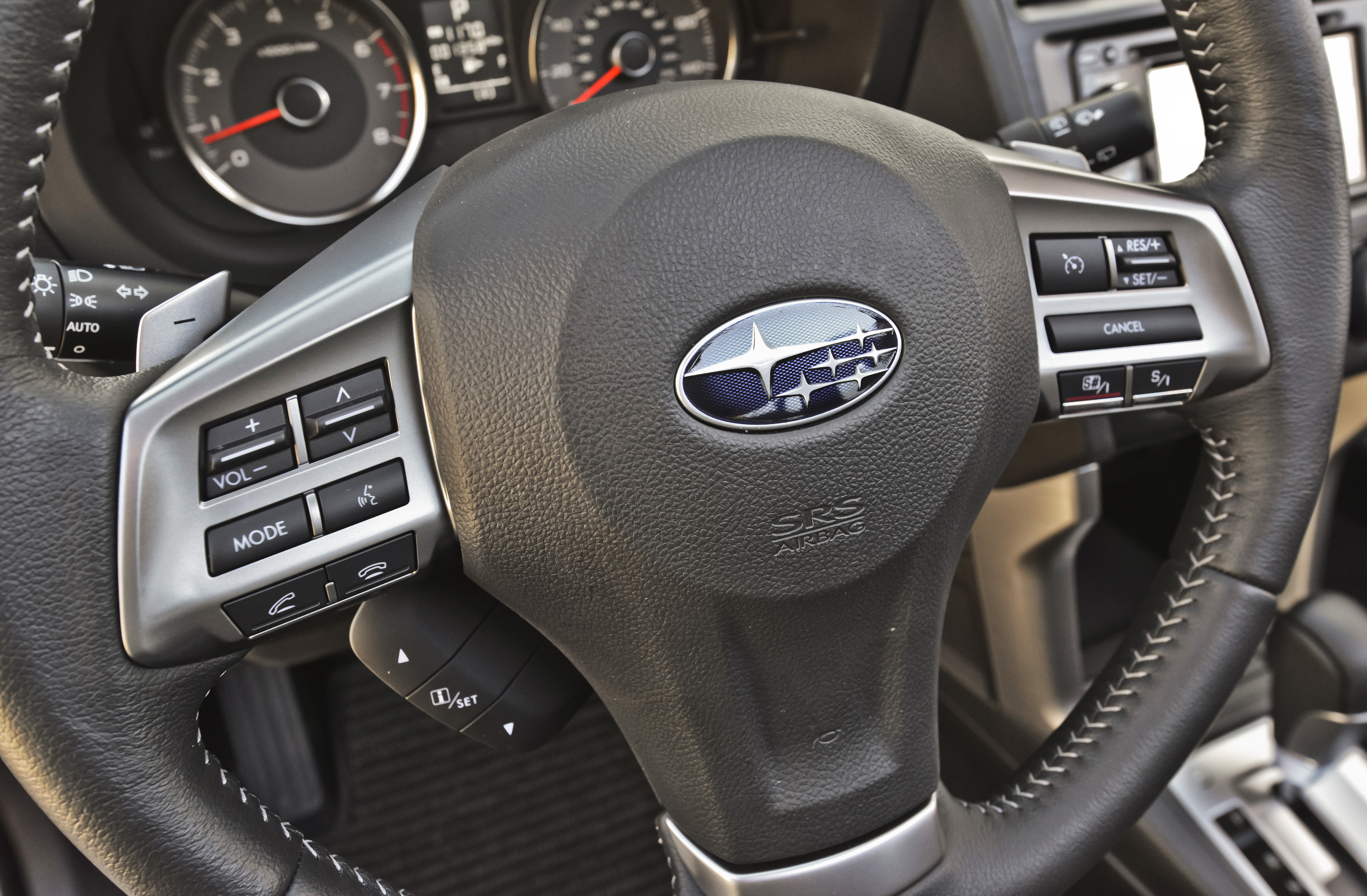
You can just see the “-” poking up above the left side of the steering wheel, which features enough controls that you rarely need to move your hands from it. Photo: Subaru Canada
Want to back up? Move the automatic gearshift to “R.” The Suby’s rearview camera kicks in automatically, complete with color-coded distance markings.
While I shifted up to keep accelerating without overtaxing the engine, there’s no similar need for downshifting. Several times I just braked to a stop without touching the “-“ paddle and the Forester put itself back into first gear, ready to accelerate from a stop. This makes for a pretty forgiving manual transmission experience – shift up when you hear the engine rev hard, and never worry about shifting down.
I did downshift anyway, to slow the Subaru when I saw things like red lights or stop signs ahead. Since the motor naturally drifts back to idle revs (somewhere near 1,000 RPM I think – I forgot to take note during the week I had the Forester), a judicious combination of letting off the gas and downshifting slows the vehicle nicely, to the point that I barely needed to brake to come to a complete stop. On a couple of occasions, I used “engine braking” to control my descent of a hill.
Another reason to downshift: if you’re passing on the highway, get a little extra power by pulling the “-“ to awaken more of the 250 horses the 2.0-liter, 4-cylinder boxer engine keeps in store. Hear the motor respond, step on the gas, execute your pass with aplomb, settle back down to cruising speeds and upshift for better fuel mileage.
If it sounds like I think a lot about driving when I, you know, drive, well, that’s the point. Encouraging other drivers to develop and maintain that kind of focus, plus getting them to keep both hands on the steering wheel, could help a lot of people drive more safely. If paddle shifters get more drivers to focus on driving and ignore stuff like phones, food and so forth while behind the wheel, then I say put them in more cars.
Six or eight gears? It’s your choice
What made Subaru’s system even more intriguing was the fact that the Forester boasts a continuously variable transmission, or CVT. This means the Subaru can move along in automatic while keeping the motor at its preferred level of exertion (around 2,000 RPM) by “shifting” through a theoretically infinite number of gears. One benefit: a CVT reduces the variance in revs normally associated with acceleration or braking, thus improving fuel consumption.
The Forester ships with several driving modes, collectively known as Subaru Intelligent Drive (SI-DRIVE). Here’s how Subaru explains it in a press release:
With Intelligent mode selected, SI-DRIVE provides a more relaxed throttle response curve, making it useful for commuting in traffic. Sport mode provides quick throttle response, powerful linear acceleration and accesses a 6-speed manual mode with steering wheel-integrated paddle shifters. In Sport Sharp mode, SI-DRIVE modifies the engine’s electronic throttle mapping to deliver even quicker throttle response and provides an 8-speed manual mode for the CVT.
I stuck to “Intelligent” mode. (BTW, Subaru’s marketing people might want to review this nomenclature. What are you saying to drivers who choose to not use “Intelligent” mode?) and didn’t bother with the other two, even though I thought about trying Sport Sharp.
As noted in the quote above, Intelligent mode offers six shift points, or gears. In Sport Sharp, you get eight shift points.
It was already brilliant to offer the experience of a semi-automatic gearshift in a CVT-equipped car, but extra kudos go to the engineer who came up with the idea of offering two sets of shift points. The CVT probably made it straightforward to offers extra gears, but it’s still an imaginative leap that driving enthusiasts will appreciate.
Driving economically
The Forester’s centre console features a multi-function display. You can choose what information shows there using controls mounted on the steering wheel.
After reviewing my choices, which included several vehicle telematics readouts, I stayed with the eco gauge, a digital readout that emulates an analog gauge. While the manual claims this gauge only shows an approximation of the fuel efficiency your driving habits return, it’s worth the occasional glance to make sure you’re keeping the needle to the right of the midpoint, in the green or “below-average” fuel consumption range.
I say the eco gauge is worth an “occasional” look for a very simple reason – the gauge is in the centre of the dash, not right in front of the driver. If you keep your eyes on the road (and really, who doesn’t?), you may not want to let your eyes linger on screens off to your right. Subaru, how about moving the Eco Gauge near, say, the tachometer?
If you’re driving up a hill, accelerating or idling, greater fuel consumption is just normal. The idea is to keep the needle in the green as much as possible using habits like cruise control on the highway and gradual deceleration and acceleration. (Should the needle move all the way to the right, the gauge flashes green to tell you you’re basically coasting, as you might if you let off the gas to coast gently to a stop.)
Overall impressions
Subaru keeps the video technology subdued in the Forester XT I drove, and that was fine with me. That left time to appreciate other things, from fine leather seats to crystal-clear music streaming from my iPod and emanating from a great sound system. Sun streaming down through the expansive sunroof felt good, and I was impressed by the cool little Subaru logos that shine from the side-view mirrors when you enter or exit the Forester.
I performed the requisite hockey bag test… just because that’s what I do.
Holding down a button on the key-fob or inside the car for a few seconds opens the power lift gate. Subaru thoughtfully provides a button on the bottom of the lift gate so you can close it without fishing for the key.
Subaru packed a capable vehicle with thoughtful touches. The result: a well-appointed crossover SUV that lets you gain a little more control (and have a little more fun) while you haul people and stuff. I’m looking forward to more surprises from Subaru – perhaps during a test drive of the upcoming version of the Impreza. Stay tuned.
